The catalytic converter crime wave will not slow down
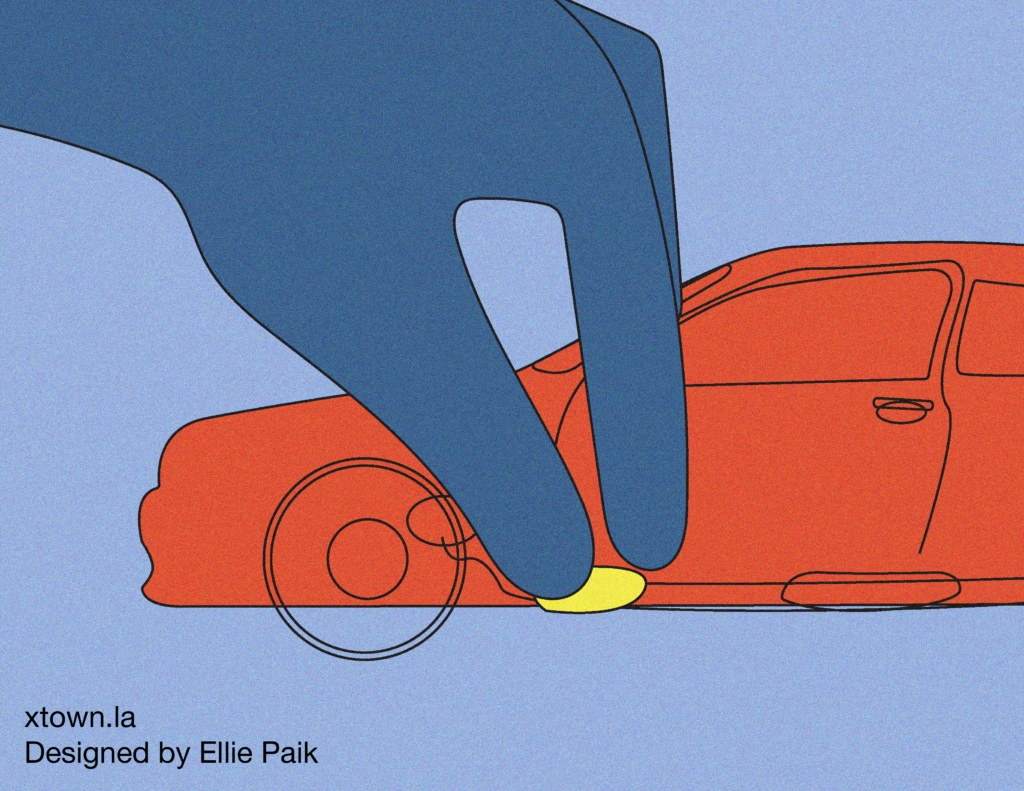
One morning last month, Cari Beauchamp walked out her front door and got into her car . She turned on the ignition and immediately heard a terrible rumbling.
“Oh God, not again,” thought the Rancho Park resident and author.
She knew the sound immediately, because the catalytic converter in her 2007 Prius had been stolen just three months prior. When she initially got it replaced—the repair was covered by insurance, though she paid a $500 deductible—her mechanic installed a cover for extra protection. Clearly, thieves were not deterred.
“It made no difference,” Beauchamp said. “They broke through it and broke my muffler at the same time.”
Beauchamp’s experience is becoming frighteningly common in Los Angeles, as auto part theft, which had been swelling for several years, exploded in late 2022. According to publicly available Los Angeles Police Department data, there were 2,760 reports of auto part theft in the last three months of the year. That compared with 1,504 in the previous quarter.
The 2,760 reports is nearly four times as many as were stolen in the same period three years prior. From Oct. 1–Dec. 31, 2019, there were 697 auto part thefts in the city.
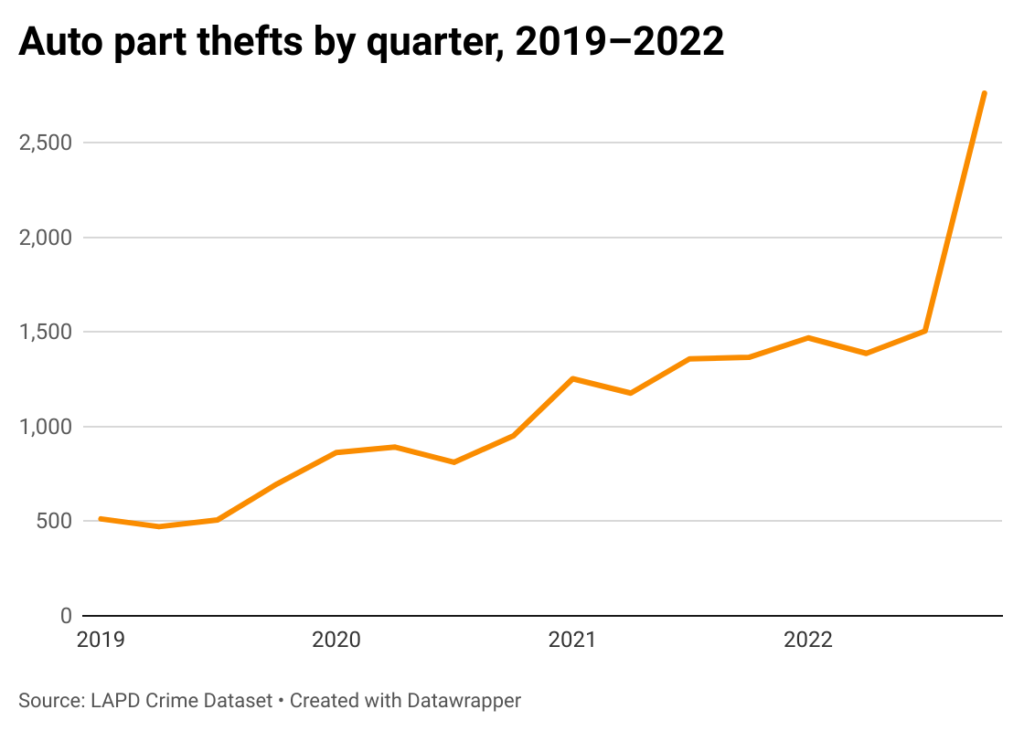
Replacement can be a hefty hit on owners, often costing several thousand dollars. But there is another big headache: time.
The surge in thefts has squeezed the supply chain. Joseph Shoukier, who owns the Precision Auto Clinic in Van Nuys, said there is now a shortage of parts, particularly for Toyota Priuses. He said it can take up to six months to get a new catalytic converter. A driver might have to leave a vehicle parked during that period.
Top-level attention
Publicly available police data does not specify the type of auto part stolen, and headlights and airbags are also sometimes taken. But the spike in catalytic converter thefts is drawing attention from LAPD Chief Michel Moore, who during the Feb. 7 meeting of the Police Commission referenced what he termed the “stark increase” in such crimes.
“Year to date, we have seen 406 more catalytic converter thefts from vehicles across the city,” Moore said, comparing the timeframe with the first five weeks of 2022.
In the entirety of last year, the LAPD fielded 7,118 reports of auto part theft. That is a 38.2% increase from the previous year. It is more than three times the thefts in both 2018 and 2019.
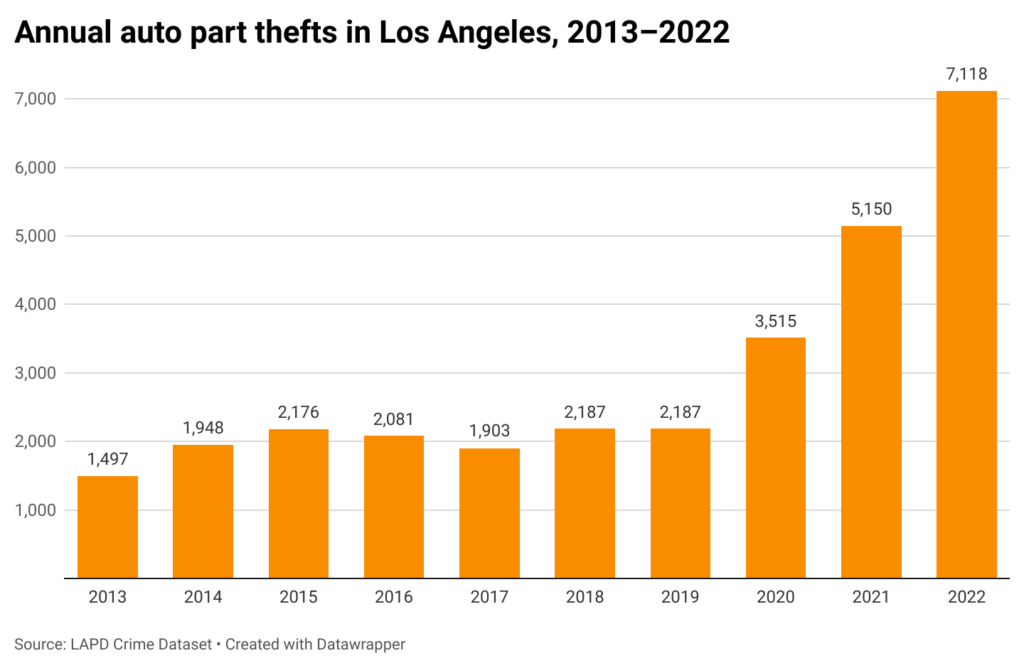
Trade group the National Insurance Crime Bureau said that across the country, catalytic converter thefts increased 1,215% from 2019 to 2022.
Not only is the crime wave unprecedented, but so are the victims. This month, the catalytic converter was stolen off the Oscar Mayer Weinermobile while the 27-foot-long vehicle was parked in Las Vegas. A temporary fix made it operable.
[Get COVID-19, crime and other stats about where you live with the Crosstown Neighborhood Newsletter]
Driving the increase
What’s behind the surge in the theft of devices that reduce harmful vehicle emissions? Money, of course. Catalytic converters contain small amounts of precious metals, which can be melted down and sold. According to a Jan. 27 statement from the NICB, rhodium is selling for $12,300 an ounce, palladium goes for $1,784, and platinum fetches $940. All are approximately twice what they were three years ago.
Also propelling the thefts is the ease of taking catalytic converters. Thieves, who often work at night and in groups, can steal one in 60-90 seconds.
At the Police Commission meeting, Moore said the department had recently arrested three people.
“They had a car full of catalytic converters and cutting equipment and so forth, and each reported that they were making $300-$500 a night as individuals going out and spending a couple hours surveying neighborhoods, finding target vehicles, sawing those items off, and then reselling them,” he said.
Yet thefts do not always go as planned. On Feb. 14, the Los Angeles Times reported, a man in the city of Palmdale crawled under a Ford Excursion and used a saw to try to cut off the catalytic converter. The noise woke a woman sleeping in the vehicle, who responded by turning on the engine and shifting into reverse. She ran over the man, who was taken to a hospital, where he died of his injuries.
Taking aim at thieves
According to LAPD data, 3,846 auto part thefts last year, or 54% of the total, involved vehicles parked on the street. But reports could come from anywhere: There were 30 thefts at an elementary school, and 14 in hotels in the city. There were three at an auto supply store.
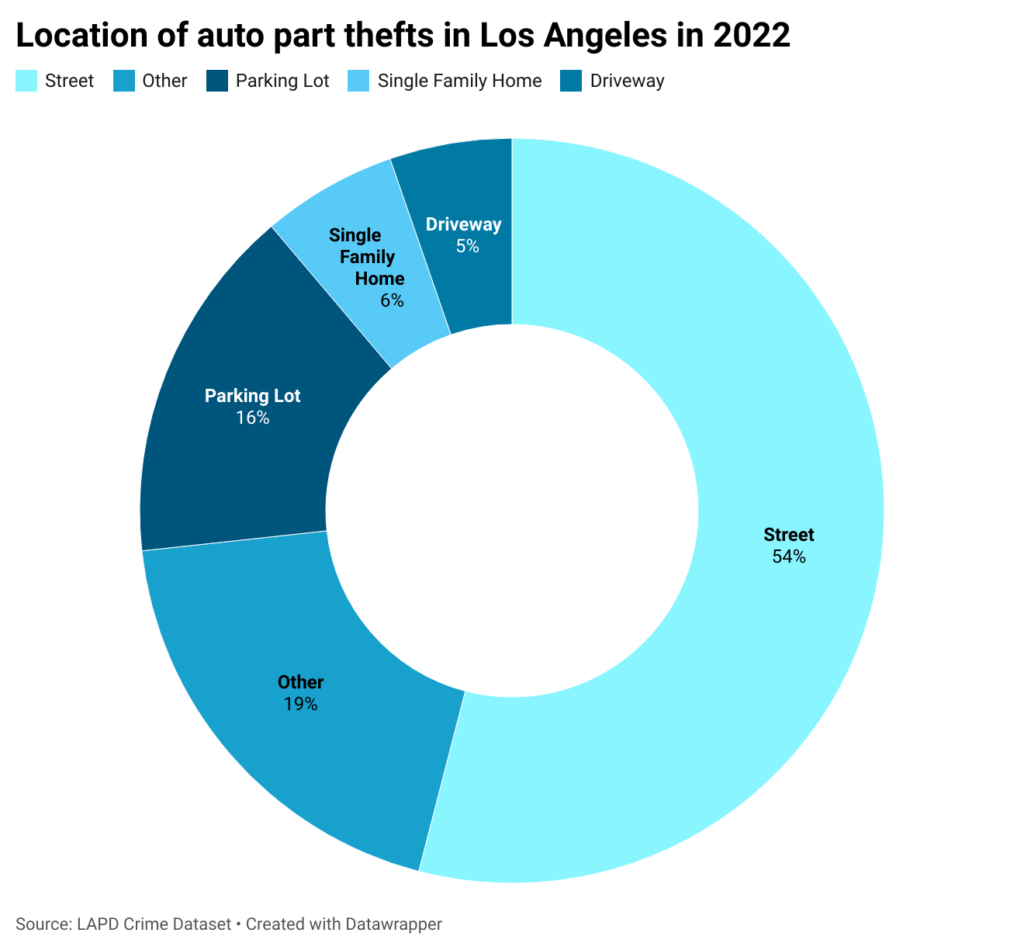
Some neighborhoods suffered more than others. According to police data, in 2022 there were 379 reports of auto part theft in car-filled Downtown. The second most frequently victimized community was Van Nuys, where 220 thefts were tallied.
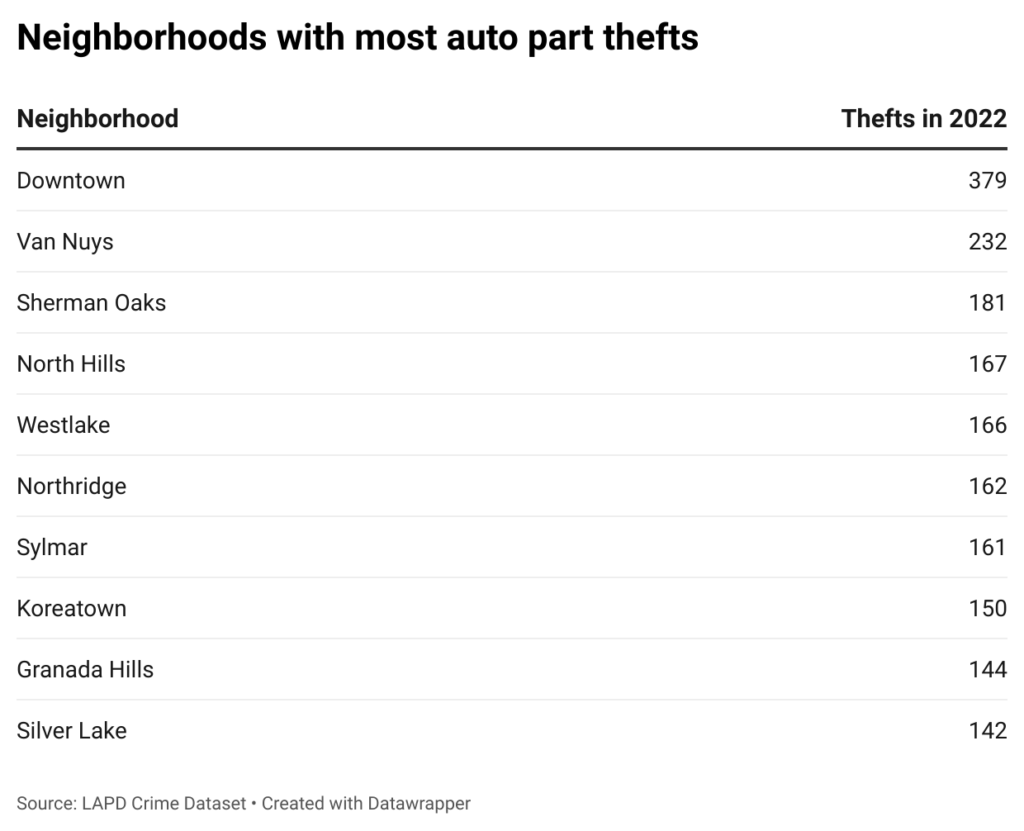
Shoukier has seen this play out in real time. The repair shop owner estimated that he has gotten a 25% increase in calls for catalytic converter replacements just in the last several months.
“People get up in the morning, say, ‘I started my car and it sounds like a motorcycle,’” Shoukier said. “That’s an indication someone has been under there and cut it up.”
Efforts are being made to combat the crime. Last September, Gov. Gavin Newsom signed a pair of laws—Assembly Bill 1740, authored by Al Muratsuchi (D-Rollings Hills Estates) and Senate Bill 1087, from Lena Gonzalez (D-Long Beach)—that crack down on those who buy stolen catalytic converters. Salvage yards and repair shops now need detailed records and documentation proving they have the right from a previous owner to purchase any device.
“You take away the market for stolen goods, you can help cut down on stealing. It’s not much more complicated than that,” Newsom said when he signed the bills.
There is also work at the federal level. In November, U.S. Senators Amy Klobuchar (D-Minnesota) and Ron Wyden (D-Oregon) introduced the Preventing Auto Recycling Theft Act. The legislation, with the nifty acronym PART, would require marking each converter with a traceable identification number and establish converter theft as a specific criminal offense.
The bill was heard this month in a pair of Senate committees.
In the meantime, the incidents continue at a heated pace in Los Angeles. There were 851 auto part thefts recorded in January, according to LAPD data. That is the fourth highest monthly total since at least 2010, trailing only the counts in each of the final three months of last year.
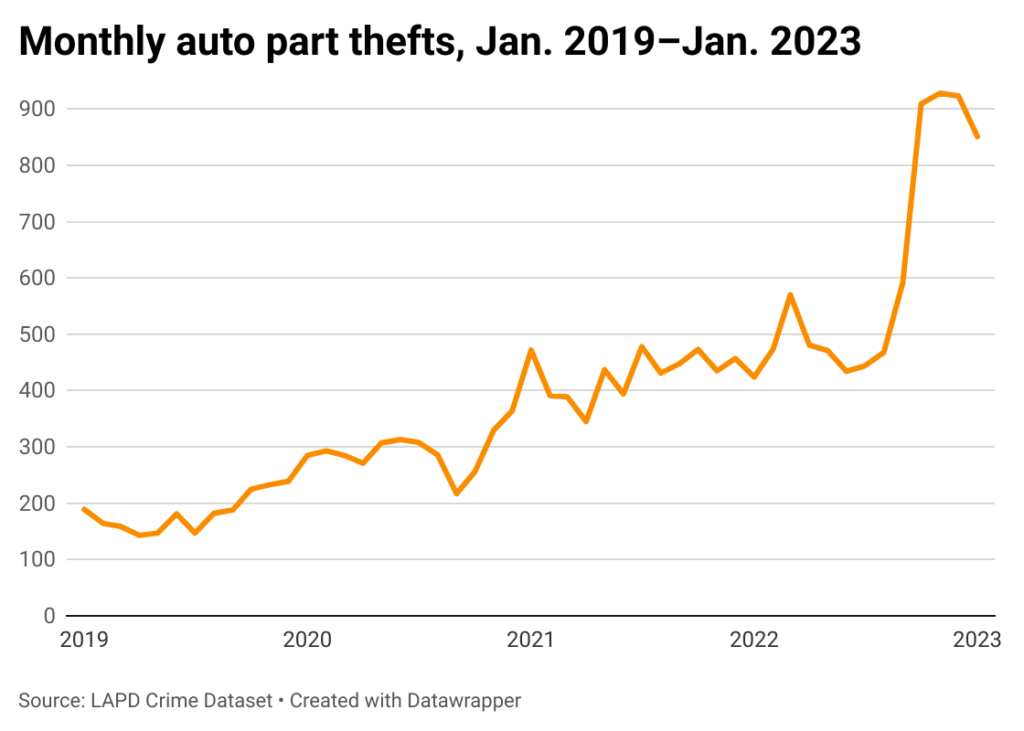
There are local attempts to thwart thieves, including events to etch a vehicle identification number onto a catalytic converter. The Los Angeles Sheriff’s Department and the Pasadena Police Department hosted one at a Toyota dealership last month.
Some car owners have installed the protective plates or cages, though as Beauchamp and others have learned, they won’t stop a thief determined to steal a catalytic converter. Shoukier has witnessed that.
“It buys a little more time, but it’s not 100%,” he said.
How we did it: We examined publicly available crime data from the Los Angeles Police Department from Jan. 1, 2010–Jan. 31, 2023. Learn more about our data here.
LAPD data only reflects crimes that are reported to the department, not how many crimes actually occurred. In making our calculations, we rely on the data the LAPD makes publicly available. LAPD may update past crime reports with new information, or recategorize past reports. Those revised reports do not always automatically become part of the public database.
Have questions about our data or want to know more? Write to us at askus@xtown.la.






